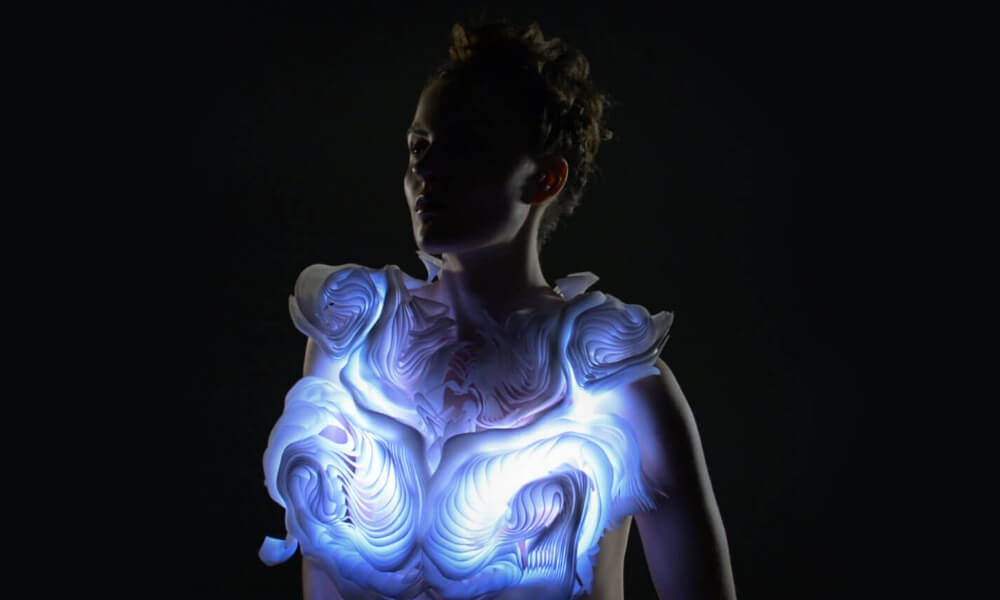3D printing improves smart fabrics
Posted By Kat Plewa on Mar 15, 2019 | 0 comments
We talked about Additive Manufacturing being used in the fashion industry numerous times. From 3D printed shoes, fabrics and jewelry to software specialized in creating new, innovative solutions for the ultimate wearing comfort. In this blog post, we will go a step further into the future and discuss the most interesting smart fabrics projects. The market is now worth $800 million increasing to $4.72 billion by 2020. Do you think smart 3D printed clothes are the future of the fashion industry?
Clothes that can see and produce light
What if our clothes could become our second, artificial skin and react to what we see? Behnaz Farahi took up on this idea. She created a 3D printed wearable that reflects on what the user is feeling depending on who they see. This project called, Cares of the Gaze, explores gaze-actuated and life-like behavior of fabrics. Her fabric is smart and interactive. Sounds impossible?
Farahi’s project is impressive, but not the only one. The artist is truly inspired by 3D technologies, without which she wouldn’t be able to develop her surrealistic ideas. Thanks to flexible 3D printing she was able to produce smart materials with abstract structures which also can change shape depending on the human’s behavior. ‘’Bodyscape’’ combines Additive Manufacturing with body motion triggered LED lights.
Smart textiles enriched by nature
Tamicare is a Manchester based company that revolutionized the industry by bringing mass produced 3D printed textiles which are highly flexible and recyclable. Their innovative technology allows for manufacturing raw materials seamlessly, with no material waste into ready to use products. It also allows for the application of conductive materials during the printing process!
Let’s take sports shoes for instance, which can take up to 100 different steps to be produced. 3D printing technology, CosyFlex by Tamicare, reduces this number to 3 operations. Thanks to Additive Manufacturing wiring and sensors needed for smart fashion or health monitoring items can be 3D printed alongside the textiles at the same time.
Cofounder and CTO Ehud Giloh commented: “sports shoes can require over a hundred individual operations during manufacturing, but Cosyflex® reduces this to three. The same is true for many other complex designs. This allows companies to produce in one location what previously required a complex global supply chain“.
3D printing also let the company explore new, natural materials, even graphene which is an absolute phenomenon in the industry as it’s the lightest and the strongest material ever discovered, read more about this topic here. A technology entrepreneur coworking with Tamicare explains: the Cosyflex® system builds a garment layer by layer. Anyone of those layers can be textile, polymer, latex or printed electronics allowing us complete freedom in the way we design smart textiles.”
Electronics built into the fabric
Nano Dimension is a leading 3D printed electronics and advanced Additive Manufacturing company. They also took an interest in electronics integrated into clothing. The issue has always been putting it all together. Electronics are sometimes fragile and should not be exposed to too much motion, folding, etc.
Therefore they should be combined with the fabric, becoming an integral part of the textile. The engineers from Nano Dimension tested conductors 3D printed in different patterns to study functionality such as conductivity, elasticity, rubbing and so on. Their research has shown that the company successfully printed silver conductors on the fabric, making it smart.
What is the future of fabric?
As you see, there are many projects being developed in the smart fabrics industry. From clothes that can interact with who you see and move according to your movements, to conductive sensors integrated into the fabric. Those type of innovative ideas can be groundbreaking not only in the fashion industry but also in healthcare. Devices for health monitoring such as blood pressure, heart rate, and others, are often electrical. What if they could be implemented in a piece of clothing, measuring the state of our health constantly?
We might not 3D print smart fabrics yet, however, we also had an interesting impact on the fashion industry with the Virus project. You can also start using Additive Manufacturing technologies with us! It’s as easy as uploading a 3D file to our online 3D printing service or contact our sales department to answer any of your questions.
Don’t forget to sign up for our Newsletter and follow us on Twitter to get the latest 3D printing News!


 Connect with Google
Connect with Google Connect with Facebook
Connect with Facebook

